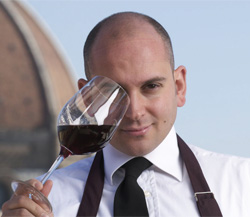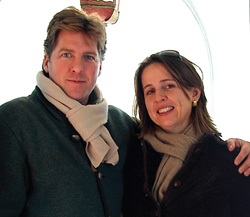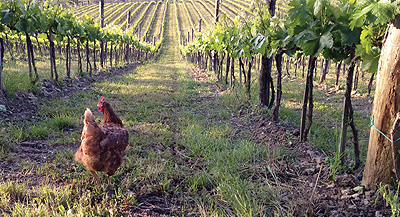In my eight years at Enoteca Pinchiorri in Florence I got to taste the best wines in the world, and to travel scouting out new wines. Yet Tuscany—especially the Chianti area, being so close to Florence—remained exciting to me and my coworkers, as we were always finding new producers.
So after ten years away—running a restaurant in NYC, and now working at my family’s winery in Le Marche—I went back to catch up on the local wine scene. I headed straight for Pinchiorri, knowing the staff would show me something distinctive and new, and checked in with the restaurant’s alumnae and other sommeliers around the region. They gave me an insider’s guide to Chianti Classico and to the less frequented regions of Chianti.
Michele Braganti’s high-altitude vineyards for Monteraponi in Radda in Chianti
1. Sangiovese on the Rise
Enoteca Pinchiorri sustains one of the most important wine programs in Europe: The cellar boasts about 80,000 bottles with well over 3,500 different labels, which the sommeliers are constantly changing.
My former coworker, Ivano Boso, is one of the original five sommeliers Giorgio Pinchiorri hired 20 years ago. Now in charge of the wine cellar, Boso spends much of his time forging relationships with wineries, so he’s a great source when you want to know what’s going on right now.
He tells me that interest in super-Tuscan wines has yet to slack off, but at the same time, he finds, the region is witnessing a revolution: Vintners are relying less on varieties like merlot and cabernet in their Chianti. He calls out Gioia Cresti as an example. Cresti took over her family’s winery, Fattoria Carpineta Fontalpino, in 1990, farming about 57 acres in Castelnuovo Berardenga, just outside of Siena. “The wines have the typical characteristics of the area: intense and open aromas and a harmonious taste—something that’s very difficult to achieve with sangiovese, but Gioia makes it seem effortless,” he says.
While Boso acknowledges that she also makes very good wines from international varieties, it’s the Chiantis he’s most taken with. “She uses traditional varieties of the area like colorino and canaiolo, which give even more complexity to her wines. They’re always very well balanced, with good acidity and velvety tannins, but especially with a personality indicative of that piece of Tuscany—something we believe in and support.”


Andrea Gori is the fourth generation of his family to run the Trattoria da Burde on Via Pistoiese in Peretola, just minutes outside of Florence, but he’s the first to take its wine program seriously. Within Chianti alone, he features about 60 different producers.
Gori tells me that he thinks Chianti, and Chianti Classico in particular, is returning to its roots, relying on sangiovese and using large barrels instead of barriques. Additionally, the fruit has gotten better: valley floor vineyards have benefitted from changes in the climate, and the vineyards replanted in the 1990s are coming into their own.
One of the districts that Gori esteems the most is Radda in Chianti, an area made famous by Montevertine, a winery that went its own way with Le Pergole Torte. Its success influenced others, such as Michele Braganti, a young grower who works with high-altitude vineyards. Tired of seeing the value of his grapes decline every year, Braganti launched Monteraponi in 2003 to develop his own interpretation of great sangiovese, blending in other local varieties including canaiolo and colorino.
Braganti’s approach recalls the Burgundian model, in his respect for the land, traditional winemaking and the practice of vinifying individual sites separately. The wines, Gori says, support his belief that sangiovese, like pinot noir, is so sensitive to climate, soil and cellar work that it’s worth the trouble, if the land permits, to invest in individual parcels.
3. The Heart of Chianti Classico
San Lorenzo is my favorite neighborhood in Florence: a part of town that’s popular for its market, and for the people and the shops that distinguish it. That’s where you’ll find La Casa del Vino, which used to be one of my regular stops. Here, the man in charge is Gianni Migliorini, who, just as his grandfather did in the early 1900s, pours wines and prepares delicious food behind the bar—small plates of anchovies sott’olio, salt cod or pickles. In the early ’80s, Casa del Vino was one of the most important enotecas in Tuscany in terms of quality and the range of bottles on offer. Today, the list is far smaller, as Migliorini has focused his selection on small Tuscan producers.
Asked to recommend a few of his current favorites, he shares two new discoveries from Lamole, a hill adjacent to Greve in Chianti, which once represented the heart of Chianti Classico. The first is I Fabbri, which the Grassi sisters, Susanna and Maddalena, launched in 2000. Their 22 acres of vineyard sit relatively high in altitude, and produce a classical, mineral-toned sangiovese. The other is Fattoria di Lamole, where Paolo Socci is working on restoring his old terraces, some of which sustain 60- and 70-year-old vines, many of them sangiovese di Lamole, also known as brunello di Montalcino. Under the Le Stinche brand, he puts out elegant Chianti Classicos with fresh, intense aromas and silky tannins.
4. A French Perspective
Thomas Vandenbossche grew up in Aniche, a small town in northern France, close to Lille. He got hooked on Italian wines when he worked at the Four Seasons in Paris with Enrico Bernardo, the youngest sommelier ever to win the Best Sommelier in the World competition, taking the title when he was just 27, in 2004. Vandenbossche has been the head sommelier at the Four Seasons in Florence for the past five years.
While his list spans all of Italy, Tuscany is his focus, and he likes to offer special tastings to show off the region’s small, little-known producers. Among the wines he calls out is a Chianti Classico from Radda, Azienda Caparsa. Paolo Cianferoni started the winery in 1982, and makes authentic and very traditional wines using only indigenous varieties, including sangiovese, colorino and canaiolo.
“Many guests at the Four Seasons—especially the foreign guests—still have a perception of Chianti as a wine served in a straw fiasco,” Vandenbossche says, “a cheap pizzeria wine. But we’re trying to explain that there are wineries like Caparsa that work in a serious way, using varieties that come from the territory and doing great work in the vineyard.”


David Gardner moved to Tuscany from Scotland 20 years ago and quickly succumbed to the pull of the vines that surround him here. He and his wife, Catherine, run Baldovino Trattoria in Santa Croce and, in 2005, opened Villa Bordoni, a small hotel and restaurant in the hilltop village of Montefioralle in Greve in Chianti. There, he’s built a list focused on the wines of Chianti Classico.
Gardner is the sort of guy who goes hunting with his chef, bags a wild boar and turns it into boar ragú with fresh pappardelle for his customers. You could call his place refined, but it’s also entirely unpretentious and deeply rooted in the countryside. So it’s not surprising that he prefers traditional wines rather than international styles. He pulls out a Chianti Classico from San Giusto a Rentennano in Gaiole in Chianti as one that excites him, explaining that he doesn’t like wines that are too fruity, soft or round. The austerity of the wine is something he associates with the Tuscan countryside, a characteristic that’s typical in Chianti. He also suggests Fattoria Ormanni as another Chianti producer in a similar mode.
“These wines are the ones I would recommend to pair with typical Tuscan cuisine,” he says—dishes like ribollita, pici con faraona and the region’s famous t-bone steak.
6. Colli Fiorentini
Carlo Cioni runs Delfina, his family’s trattoria in the medieval town of Artimino, a few miles outside of Florence. Cioni is a man from another time who loves real and authentic things, like the cuisine he offers to his guests—a cuisine linked to the territory, specialized in the wild game that can be found in the Florentine hills.
Delfina’s wine list is curated by Primo Ammallati, who, like Cioni, seeks out wines he describes as true and authentic, expressive of fruit rather than wood. His list is focused on selections from Carmignano as well as a number of small Chianti producers in the Colli Fiorentini he’s found that make very interesting wines.
In particular, he calls out Villa Corliano, a winery in Lastra a Signa, in the Florentine hills. There, the Pancani family cultivates mainly indigenous grapes, producing both an entry-level Chianti that’s fruit-forward and enjoyable and a Riserva that’s classic in its austerity.
7. Rúfina Traditions
Simone Draisci was at Pinchiorri in Florence during my time there; now he runs Antica Porta di Levante, a little inn in Vicchio, a small, rustic town in the Mugello region near Chianti Rúfina. Although it’s not a heavily travelled area, people come for a taste of the region. Draisci offers a cuisine strictly linked to the local traditions, like the famous tortelli di patate del Mugello.
He’s also known for his wine list, focused on Chianti Rúfina and particularly on wines from around Dicomano—a small village a few miles from Vicchio that has seen a viticultural boom in the last few years.
Among his favorite producers, Frascole stands out. Run by Enrico Lippi since 1996, Frascole produces a sturdier and more austere sangiovese than the classic Rúfina wines (think Pontassieve). Draisci surmises that the character might be due to more significant altitude, to the subsoil that varies between clay and galestro and to the optimal exposition. Lippi’s traditional fermentations and use of large format wood make for wines that need a little age before they can be fully appreciated.
8. New Classics
Filippo di Bartola got into restaurant business when he was 14 years old. His aunt, who owned a little seaside establishment in Forte dei Marmi, let him help out waiting tables. It started out as a joke, he says, but he immediately knew he would become a restaurateur.


He has been particularly taken by the wines of Rocca di Montegrossi, a winery Marco Ricasoli-Firidolfi started restoring in 2000. “He’s known how to combine the strength of tradition with the new demands of the market,” di Bartola says, “producing Chianti Classicos from a base of sangiovese to which he adds canaiolo, colorino and pugnitello, indigenous varieties that lend depth and complexity.”
As we talked about the current focus of his fellow restaurateurs on the region’s traditional wines, wines with a clear philosophy of production that is tied back to the land, he marveled, “It’s enough to step back ten years and realize that, at one time, we would have dreamed all of this.” ■
Resources:
Braganti, A.I. Selections, NY
Caparsa, Artisan Wines, South Norwalk, CT
I Fabbri, Siena Wines, Springfield, VA
Frascole; Rocca di Montegrossi, T. Edward Wines, NY
Fattoria Carpineta Fontalpino, Soilair Selection, NY
Fattoria Ormanni, Virtuoso Selections, Austin, TX
Montevertine, Rosenthal, NY
San Giusto a Rentennano, Michael Skurnik Wines, Syosset, NY
Villa Corliano, Saranty Imports, Harrison, NY
This story was featured in W&S April 2013.
This story appears in the print issue of April 2013.
Like what you read? Subscribe today.















